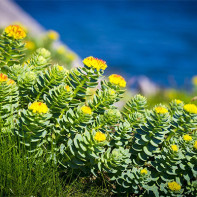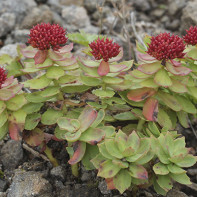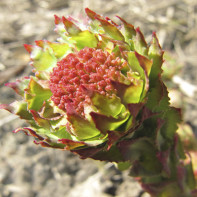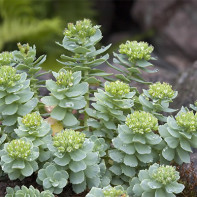Rhodiola rosea: medicinal properties and contraindications
Rhodiola rosea is a plant that in modern medicine is considered primarily as an adaptogen (along with, for example, Eleutherococcus). But in fact, its possibilities are much wider. Rhodiola rosea has an impressive range of healing properties and has virtually no contraindications.
- Chemical composition
- How it looks and where it grows
- Collection and storage
- The healing properties of Rhodiola rosea
- For women
- For men
- During pregnancy
- When breastfeeding
- For kids
- When losing weight
- Rhodiola rosea in folk medicine
- With vitamin deficiency
- With anemia and hypotension
- With atherosclerosis
- With bronchitis and respiratory system diseases
- With varicose veins
- Types of healing compounds
- Infusion
- Tincture
- Decoction
- Tea
- Application in cosmetology
- Rejuvenating face lotions
- Homemade facial skin tonic in winter
- Homemade Acne Tonic
- Lotions for skin care around the eyes
- Facial Whitening
- Contraindications
- Interesting Facts
Chemical composition
This plant is well studied in terms of its chemical composition. In total, there are about 140 ingredients that have a therapeutic effect, with the highest concentration found in the root of Rhodiola rosea. The most important components for medicine are:
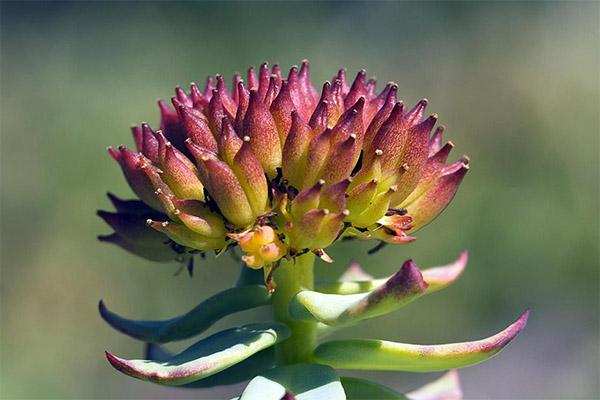
- Salidroside (up to 1% at the root of the plant). It was his presence that determined the adaptogenic properties of the plant, that is, its ability to increase the body's resistance to the effects of negative environmental factors. In addition, studies have shown that this component prevents the development of certain malignant tumors and has an antiviral effect.
- Rhodioloside. This is another component that is typical for this plant. It also has adaptogenic properties and has a stimulating effect on the central nervous system. The combination of these two components, as shown by studies, inhibit the growth of prostate tumor cells, and also have antimicrobial activity against the causative agent of gonorrhea.
- Glycosides. A whole group of substances that beneficially affects the cardiovascular system and the work of the heart muscle. It also gives the plant the properties of a soft diuretic, which allows it to remove excess fluid.
- Flavonoids. Substances that have antioxidant properties. Basically, it is quercetin, hyperoside and some other substances, which, among other things, can normalize blood pressure and heart rate, provide flexibility and elasticity of blood vessels, while at the same time reducing their permeability.
- Tannins (up to 20% in the rhizome). These are mainly compounds of the pyrogall group. They have the ability to make changes in the structure of the protein, which leads to the formation of a protective albuminate film. It is important in that it has a bactericidal effect on pathogenic microorganisms. In addition, these substances are responsible for the astringent properties of the plant, which allows it to be used in the treatment of certain diseases of the oral cavity, as well as burns and wounds.
- Anthraquinones. This is a group of substances that helps strengthen the immune system. But at the same time, it gives the plant rhizome its laxative properties.
- Coumarins. These substances have antitumor activity, preventing the appearance of metastases.
- Organic acids - oxalic, citric, succinic, etc. Each of these components has its own range of medicinal properties, while it is quite wide. For example, oxalic acid is involved in hematopoiesis, providing the body with potassium and iron, and normalizes the secretory function of the stomach and pancreas. Malic acid is effective for constipation, helps to normalize blood circulation and improve vision, helps to establish metabolism.Succinic acid reduces the level of "bad" cholesterol and provides the body with energy, and also reduces blood sugar. Citric acid is also involved in metabolic processes.
- Essential oil (up to 1%). Scientists have proven its bactericidal, antiseptic, anti-inflammatory and even analgesic properties. In addition, it is believed that it has a mild sedative effect.
By the way, it is the essential oil that gives the plant a pleasant smell, reminiscent of the aroma of much more expensive rose oil. Also, plant fats and proteins, wax and sugars (glucose and fructose, which are important sources of energy for the human body) are found in the rhizome.
The root of Rhodiola rosea also contains trace elements such as manganese, which is responsible for the normal functioning of the reproductive system, restoration of lipid metabolism and the absorption of carbohydrates, zinc with its anti-inflammatory properties and copper, which has antiseptic and bactericidal effects.
How it looks and where it grows
Rhodiola rosea is a herbaceous perennial with a fairly powerful root system. It looks like this - its thick rhizome passes into an equally solid root. The stems of the plant are straight, they practically do not branch. The height of the plant is 25–65 cm. At the base, the stem is covered with leaves resembling scales. Above the stem, the leaves are larger, differ in oblong shape and a dark green tint. Their edges are serrated, less often whole. At the ends of the stems inflorescences blooming, consisting of small yellow or greenish flowers.
Rhodiola blooms in early summer and blooms before the end of August. In July, reddish or yellow fruits may already appear. Reproduction occurs either by seeds or pieces of rhizomes.
Under natural conditions, Rhodiola rosea is found in Siberia and in the European part of Russia (but only in the north). You can find this plant in the Urals, Transbaikalia, Chukotka, and Altai. However, in some regions it is already listed in the Red Book. Therefore, in the middle lane it is usually purposefully cultivated as a medicinal plant.
Collection and storage
For medicinal purposes, mainly rhizomes of this plant are used. Not every instance is suitable for this. We need to look for plants in which the aerial part consists of more than two stems. Harvesting is done after seed ripening.
Rhizomes are carefully removed from the ground, cleaned of dirt, and then washed under cold running water. It is necessary to carefully examine all the raw materials, to check for rotted parts or flaking bark. They get rid of such problem areas, and the stems must be cut off.
Then the rhizomes are cut into pieces with a length of - 10 cm. It is recommended to dry them on a stove or in a special dryer at a gentle temperature of 50-60 degrees. In the old days they were dried in a traditional oven. They should not be kept in the sun, otherwise the raw material will lose its healing properties.
A properly dried root has a dull hue, but if you scrape it a little, a lemon yellow tint will become visible. At the fracture, such a root looks pinkish-brown. When dried, it still retains the smell of a rose and a bitter-astringent taste.
After drying, it is recommended to keep the medicinal raw materials in a dry and dark place so that sunlight does not penetrate there, accelerating oxidative processes. It is best to store dried root in paper bags. The maximum shelf life is up to 3 years.
By the way, Rhodiola rosea can be grown on a summer cottage. But this greatly depletes the soil, and after one harvesting this site is not recommended for use for 10 years.
The healing properties of Rhodiola rosea
This plant has a wide range of medicinal properties. It can be used:
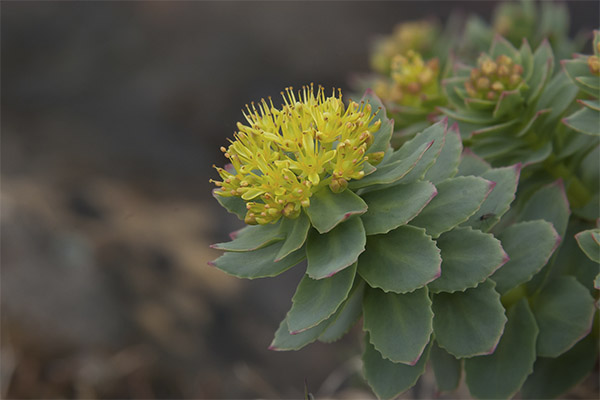
- As an anti-inflammatory agent for gout and arthritis.
- With various diseases of the reproductive system, including polycystic ovary.
- To increase pressure with hypotension.
- Improvements during menopause.
- Normalization of the menstrual cycle, with dysmenorrhea and violation of puberty.
- Improvements in cognitive function, memory, and mental activity.
- Normalization of hearing and vision.
- Excretion of toxins and radionuclides.
In addition, the use of drugs based on Rhodiola rosea has a beneficial effect on the condition of the liver and the hepatobiliary system as a whole. The substances contained in this plant increase the body's resistance to any negative environmental influences, both physical and chemical, and biological (for example, infections). Finally, Rhodiola rosea supports the normal function of the thyroid gland and adrenal glands, which allows for the normal production of hormones.
Additional studies of this plant are currently underway. Earlier experiments revealed that its drugs can affect not only the central nervous system, but also cognitive functions of the brain. In particular, some scientists believe that rhodiola-based products can change the bioelectric activity of the brain by acting on its stem part. This opens up a new field of application of funds based on this plant, but so far this area needs more in-depth research.
For women
For women, Rhodiola pink is important for several reasons. Firstly, it really helps to alleviate stress. Secondly, it is prescribed for the complex treatment of various gynecological pathologies and disorders of the menstrual cycle, since it has a good effect on the reproductive system as a whole. Thirdly, it becomes an important part of menopause therapy due to the high content of flavonoids and other active substances.
In addition, a number of studies show that Rhodiola rosea may be useful in mastopathy and as an agent against breast tumors.
For men
For representatives of the stronger sex, Rhodiola rosea is good in that it reduces the level of "bad" cholesterol in the blood, and men face this problem much more often than women. In addition, its anti-inflammatory properties and the possibility of using it for the treatment and prevention of diseases of the prostate are important.
During pregnancy
Some herbalists advise expectant mothers to take drugs based on Rhodiola rosea as a tonic and anemia prevention. However, official medicine is categorically against such use, since it can increase the tone of the uterus and lead to miscarriage in the first trimester or premature birth in the second.
When breastfeeding
In the first month after childbirth, a young mother should refrain from using funds based on Rhodiola rosea, since during this period the child’s body is particularly sensitive, and any herbs can provoke an allergy. But in the future it is not recommended to use these funds, since they have a stimulating effect, and children can become restless, their sleep may be disturbed.
For kids
Funds based on Rhodiola rosea are practically not prescribed for children, unless the child suffers from frequent colds. Basically, tincture or decoction of Rhodiola root is prescribed for children over 12 years old, especially in cases where you need to mitigate the effects of stress or help with learning and concentration. In no case should you give this child a drug without a doctor's prescription.
When losing weight
Due to the unique chemical composition of Rhodiola, pink can also be used for weight loss. Here, several properties of this plant are manifested immediately.On the one hand, it acts as an adaptogen, which makes it easier for the body to tolerate even fairly strict low-calorie diets and provide it with trace elements and vitamins (rhodiola rhizome contains, for example, vitamin C and nicotinic acid). On the other hand, drugs based on it activate metabolic processes and lipid metabolism, which allows you to get rid of extra pounds.
And while Rhodiola has another important property. It has the ability to enhance regeneration processes. When losing weight, very often the tissues lose their elasticity, and even getting rid of extra pounds in the end does not help to get a toned figure. However, Rhodiola enhances the regeneration processes, and the tissues recover faster.
To get rid of excess weight, it is recommended to take a decoction of the rhizome of this plant. On 1 tbsp. a spoonful of chopped dry root take a glass of boiling water and heat for another 10 minutes in a water bath. Then it is cooled and passed through folded gauze or filter paper before use. This tool is recommended to be taken twice a day, 100 ml for half an hour before breakfast and before dinner. The maximum duration of the course is 3 weeks.
You can also include rhodiola grass in the diet. It contains the same beneficial substances as rhizomes, only in a lower concentration. For example, even with a strict diet, you can periodically use a salad of young shoots and fresh leaves of a radiola. For 50 g of herbs, take 60 g of grated carrots, 7-10 g of dried walnut kernels and 1 tbsp. a spoonful of unsweetened yogurt for dressing. Such a salad can be an excellent snack - it will relieve the feeling of fatigue that occurs by the middle of the day.
Rhodiola rosea in folk medicine
In herbal medicine, Rhodiola rosea (also called the golden root) has been used for a very long time. It is not surprising that in folk medicine there are recipes based on both its root alone and complex fees, which include other herbs.
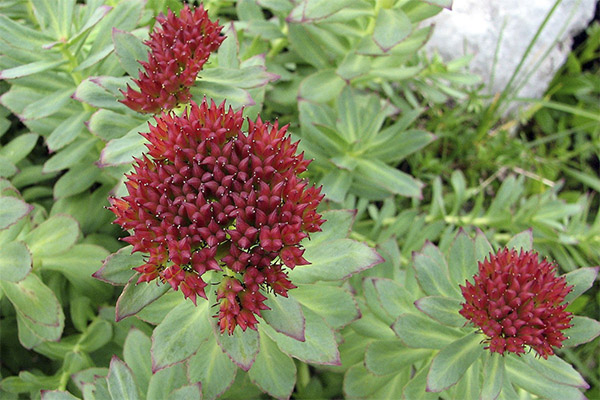
Rhodiola rosea-based products are used for bronchitis and diseases of the respiratory tract, to restore strength after severe bacterial and viral infections, to restore thyroid function, normalize blood glucose levels, etc. Below will be considered recipes for various diseases.
With vitamin deficiency
If a person experiences general weakness, gets tired quickly, suffers from sleep disturbances, the problem may be a lack of vitamins. In order to make sure of this, they are tested. And according to the results of such studies, the doctor can prescribe the use of drugs based on Rhodiola rosea. For example:
- Every day, 3 times a day before main meals, take 1 teaspoon of broth of Rhodiola root.
- Regularly 3 times a day to take 1 tbsp. a spoonful of golden root broth mixed with 2 tbsp. spoons of fresh dandelion juice.
- Make a collection based on the crushed root of Rhodiola, dried rosehip berries and currants, carrot root (take all ingredients in equal proportions). Select 3 tbsp. tablespoons of this mixture per 400 ml of boiling water, heat in a water bath for 10 minutes, leave for half an hour, then filter and take 100 ml before main meals.
Finally, you can make herbal tincture. To do this, take the nettle grass collected in May (about 200 g) and fill it with the finished pharmacy tincture of Rhodiola (500 ml). This tool is insisted in the cabinet for a week, then filtered and poured into a container of dark glass. The drug is taken 1 teaspoon before breakfast and a second time - before bedtime.
With anemia and hypotension
To increase blood pressure, it is recommended to take such an infusion - 10 g of crushed dried raw materials per 200 ml of boiling water. Insist it for 4 hours. This volume is divided into 2-3 doses per day.
If you have confirmed anemia, you can use one of two recipes - either take tea from the golden root 100 ml twice a day half an hour before meals, or make a tincture. In the second case, take 100 g of crushed golden root in 0.4 l of vodka. Tincture is kept in a dark place, periodically shaking.For anemia, take 15 drops three times a day before meals. It is recommended to dilute the tincture slightly with water before use. The duration of treatment is no more than 2-3 weeks.
To prevent anemia, it is recommended to take a classic decoction of the golden root - 1 teaspoon a day half an hour before meals.
With atherosclerosis
To improve the condition of blood vessels, you can take:
- Tincture of the golden root - 30 drops twice a day, diluted with a small amount of water, half an hour before meals. The course of treatment is a month. Then take a break for 4 weeks, and after that, if necessary, you can repeat the course.
- Yogurt mixed in equal proportions with a decoction of Rhodiola rosea. This tool is taken in a glass twice a day half an hour before meals. The maximum duration of the course is two weeks.
For the prevention of atherosclerosis, golden root tea is prepared, prepared as described below. You can drink it in a course - for a whole month.
With bronchitis and respiratory system diseases
In acute bronchitis, taking agents based on the golden root can be taken in various ways. For example, compresses based on a warm decoction of Rhodiola mixed with honey help well. They are placed on the chest for 15-20 minutes, until they have cooled, and on top they are covered with a warm scarf or plaid.
Also, with acute bronchitis, they drink a warm broth - 1 teaspoon twice a day half an hour before meals. When the exacerbation goes away, you can drink tincture instead of broth - 20 drops, diluted with water, twice a day half an hour before meals. In chronic bronchitis, the decoction stage is missed and tincture is taken immediately. The duration of the course is at least a month.
With varicose veins
Rhodiola rosea also helps in the treatment of varicose veins. They drink it in the form of tincture - 20 drops, diluted with water, three times a day, 20 minutes before eating. The duration of treatment is no more than two weeks. Then they arrange a break of the same duration and repeat the course again, and preferably even two. The most effective such treatment will be in the winter.
Rhodiola is also used for healing baths. Water for them should be cold. It is poured into the basin so that the water completely covers the ankles. Then in the prepared liquid add 1 tbsp. spoon of tincture of golden root. Feet are not just kept in this bath, but they are trying to trample and walk in place to disperse blood circulation without vasodilatation. The procedure should take 2-3 minutes, then the feet are wiped dry. Gradually, the duration of the baths can be increased.
Types of healing compounds
In pharmacies, you can find a ready-made extract or alcohol tincture of Rhodiola rosea. In folk medicine, decoctions, infusions and tea based on this plant are used. For example, decoctions are recommended for diarrhea, headaches, menorrhagia. Infusions are drunk for respiratory infections, tea is used for anemia and diabetes. Diluted tincture is used to rinse with diseases of the oral cavity, respiratory tract, taken orally for toothache.
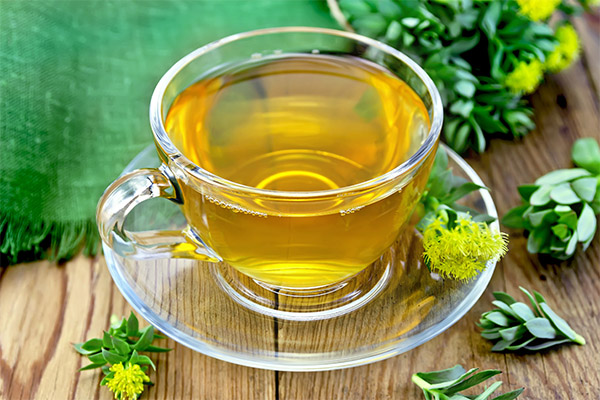
It is also possible external use of this tool. It is prescribed for conjunctivitis caused by various causes, as well as for skin diseases. In such cases, decoctions and infusions are used in the form of lotions. Some herbalists advise using these funds for douching with gynecological pathologies.
Infusion
There are several recipes for infusions that differ in the concentration of the active substance. If we are talking about the infusion, which is prescribed for colds, then it is prepared as follows - take 15 g of the root, chop, pour a glass of boiling water and insist for three hours. Such a tool is also used for some diseases of the digestive tract.
If we are talking about the infusion, which is used as an external remedy, for example, in the treatment of purulent wounds and bedsores, when lotions are made of it, then a less concentrated remedy is suitable - 10 g of crushed root per 300 ml of boiling water. The tool is insisted in a thermos for 4 hours.
Tincture
The classic version of the preparation of such a tincture - 50 g of pre-crushed raw materials is poured into 400 ml of ethyl alcohol (diluted with water) or high-quality vodka and insisted in a dry, dark place for two weeks, periodically shaking. Before use, be sure to filter the tincture. If a person has never taken it before, you need to start with a minimum dose of 5 drops, gradually increasing it to 20 drops and carefully monitoring the reaction. A dosage of 20 drops three times a day is enough to treat diabetes, hypotension, and even erectile dysfunction.
In some recipes, it is recommended to take less raw material - only 40 g, grinding it into powder. There are also recipes that suggest insisting the remedy for only 10-12 days. As a rule, the finished tincture in such cases is used for cosmetic purposes or for rinsing the mouth in the treatment of stomatitis.
Decoction
As a rule, a decoction of this tool is prepared in only one way. Take 1 teaspoon of dry chopped rhizome and pour 200 ml of boiling water, and then bring it to a boil again and boil for 10–20 minutes (sometimes the concentration varies slightly). The finished product is filtered and filtered. Take it for 1 tbsp. spoon three times a day. Most often, such a remedy is prescribed for diabetes mellitus, in the treatment of erectile dysfunction, as well as in the recovery period after internal bleeding, including uterine bleeding.
It is also believed that the decoction has analgesic properties. Therefore, it is drunk with migraines and toothache. It is also indicated for external use, mainly in cosmetology, as will be described below.
Tea
In this form, Rhodiola is most often taken to strengthen immunity and in the complex treatment of viral diseases. Brew tea like this - at 1 tbsp. take 1 liter of boiling water in a spoonful of crushed raw materials, bring the product to a boil again, cover with a lid and let cool for an hour, and filter before use. To improve the taste of the drink, add a little honey to it. Take the drug in 1 glass after breakfast and lunch.
Application in cosmetology
The unique chemical composition allows the use of Rhodiola in the perfume industry, where its essential oil and extracts are added to shampoos, balms, lotions and face creams, and in home cosmetology. For example, on its basis make such means:
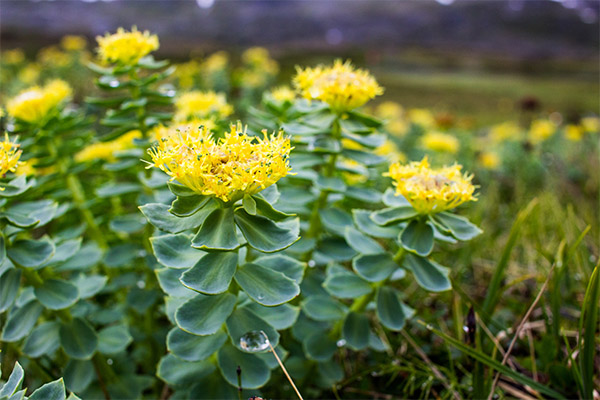
Rejuvenating face lotions
To do this, take 10 g of crushed Rhodiola root in a glass of water, bring to a boil, keep on low heat for another 5-10 minutes, cool and filter. On the basis of the broth make lotions for the skin of the face or use this tool instead of tonic.
Homemade facial skin tonic in winter
According to the recipe described above, a decoction of Rhodiola rosea is prepared. A fresh apple is taken, cut into halves, dipped in a rhodiola broth and then massaged into the face with the help of these halves, applying them to the skin from the side of the slice. Apple juice is mixed with broth of Rhodiola, providing the skin with vitamins, increasing its tone and giving it elasticity.
Homemade Acne Tonic
It is prepared on the basis of a decoction of Rhodiola rosea, in which several drops of tea tree essential oil are added. Such a tool is recommended to wipe the skin in the morning and evening.
Lotions for skin care around the eyes
To do this, take 2 tbsp. spoon decoction of the root of Rhodiola rosea and flowers of pharmaceutical chamomile. The finished product is filtered before use. Cotton swabs are dipped in this liquid and then kept on the eyes for 15 minutes to get rid of puffiness.In addition, it is recommended to wash with this product to increase the tone of the delicate skin around the eyes.
Facial Whitening
Take parsley, finely chopped, pour boiling water, leave for half an hour. Then mixed with a decoction of Rhodiola rosea (in equal proportions), filter and rub the skin with this lotion 2-3 times a day. It is believed that this tool also helps with freckles.
In addition, the bleaching lotion is also prepared on the basis of cucumber juice mixed with a decoction of Rhodiola rosea (also in equal proportions).
In order for the curls to be healthy and shiny, it is recommended to add 5 drops of rhodiola root tincture to a regular portion of shampoo, which is used for daily shampooing.
In order to prevent hair loss, it is recommended to make lotions based on freshly squeezed grape juice and alcohol tincture of Rhodiola root. To do this, take 10 drops of tincture in a glass of juice (no longer needed so as not to dry the skin) and rub this product into the hair roots and scalp half an hour before washing. After that, a plastic shower cap is put on the head, and wrapped with a terry towel on top.
Contraindications
Although Rhodiola rosea is considered a low-toxic plant, in some cases it is still contraindicated. Basically, this applies to situations such as hypertensive crises, fever, or seizures of various origins. The fact is that Rhodiola has a stimulating effect on the central nervous system, and this can only aggravate the situation.
At the same time, regarding the possibility of using drugs based on Rhodiola rosea during pregnancy and lactation, doctors have no consensus. A number of experts believe that during pregnancy, you should refuse to take such drugs. But some therapists believe that with anemia caused by pregnancy, it would be worth just to use funds based on Rhodiola. In any case, it is necessary to consult a doctor before making a final decision.
Interesting Facts
Rhodiola rosea, also called the golden root or Altai ginseng, has been used as an adaptogen since the 1970s, when it gradually began to displace tinctures of Eleutherococcus from this niche. It is interesting that in Altai this plant has been known since ancient times for its healing properties. It was believed that the one who finds the root of this plant will be lucky for the rest of his days, and he will live for a very long time. The places where Rhodiola grows were kept secret by the indigenous population, however, smugglers still sent valuable raw materials to China, where they were in high demand.
Modern science discovered this plant only in the 1960s, when it was first discovered by the Soviet expedition. Rhodiola was indeed a very valuable plant. But more importantly, it is very rare, it grows slowly, which affects the possibility of replenishment of reserves, and the barbaric destruction in the 1980-1990s led to the fact that in some regions Rhodiola was listed in the Red Book. Scientists are considering the possibility of laboratory tissue growth of this plant. But the samples obtained in this synthetic way are significantly inferior to natural analogues in the content of useful substances. So the best way is to cultivate this plant in compliance with harvesting standards and time to restore the population.
«Important: all information on the site is provided exclusively in fact-finding purposes. Before applying any recommendations, consult with a profile specialist. Neither the editors nor the authors are liable for any possible harm caused materials. "

